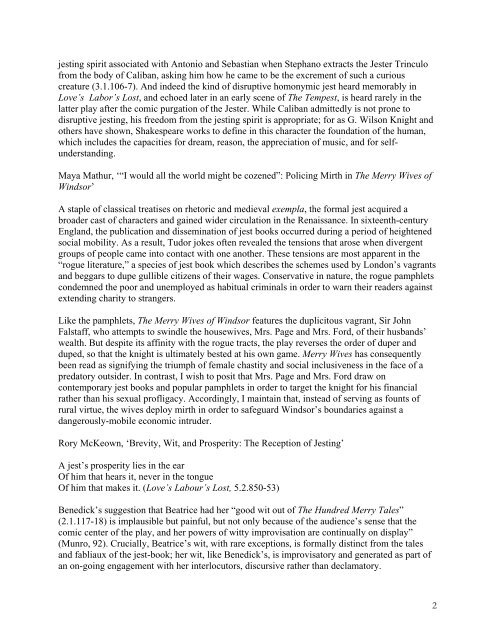1 Jests in Early Modern Culture Seminar Leader - Shakespeare ...
1 Jests in Early Modern Culture Seminar Leader - Shakespeare ...
1 Jests in Early Modern Culture Seminar Leader - Shakespeare ...
Create successful ePaper yourself
Turn your PDF publications into a flip-book with our unique Google optimized e-Paper software.
jest<strong>in</strong>g spirit associated with Antonio and Sebastian when Stephano extracts the Jester Tr<strong>in</strong>culo<br />
from the body of Caliban, ask<strong>in</strong>g him how he came to be the excrement of such a curious<br />
creature (3.1.106-7). And <strong>in</strong>deed the k<strong>in</strong>d of disruptive homonymic jest heard memorably <strong>in</strong><br />
Love’s Labor’s Lost, and echoed later <strong>in</strong> an early scene of The Tempest, is heard rarely <strong>in</strong> the<br />
latter play after the comic purgation of the Jester. While Caliban admittedly is not prone to<br />
disruptive jest<strong>in</strong>g, his freedom from the jest<strong>in</strong>g spirit is appropriate; for as G. Wilson Knight and<br />
others have shown, <strong>Shakespeare</strong> works to def<strong>in</strong>e <strong>in</strong> this character the foundation of the human,<br />
which <strong>in</strong>cludes the capacities for dream, reason, the appreciation of music, and for selfunderstand<strong>in</strong>g.<br />
Maya Mathur, ‘“I would all the world might be cozened”: Polic<strong>in</strong>g Mirth <strong>in</strong> The Merry Wives of<br />
W<strong>in</strong>dsor’<br />
A staple of classical treatises on rhetoric and medieval exempla, the formal jest acquired a<br />
broader cast of characters and ga<strong>in</strong>ed wider circulation <strong>in</strong> the Renaissance. In sixteenth-century<br />
England, the publication and dissem<strong>in</strong>ation of jest books occurred dur<strong>in</strong>g a period of heightened<br />
social mobility. As a result, Tudor jokes often revealed the tensions that arose when divergent<br />
groups of people came <strong>in</strong>to contact with one another. These tensions are most apparent <strong>in</strong> the<br />
“rogue literature,” a species of jest book which describes the schemes used by London’s vagrants<br />
and beggars to dupe gullible citizens of their wages. Conservative <strong>in</strong> nature, the rogue pamphlets<br />
condemned the poor and unemployed as habitual crim<strong>in</strong>als <strong>in</strong> order to warn their readers aga<strong>in</strong>st<br />
extend<strong>in</strong>g charity to strangers.<br />
Like the pamphlets, The Merry Wives of W<strong>in</strong>dsor features the duplicitous vagrant, Sir John<br />
Falstaff, who attempts to sw<strong>in</strong>dle the housewives, Mrs. Page and Mrs. Ford, of their husbands’<br />
wealth. But despite its aff<strong>in</strong>ity with the rogue tracts, the play reverses the order of duper and<br />
duped, so that the knight is ultimately bested at his own game. Merry Wives has consequently<br />
been read as signify<strong>in</strong>g the triumph of female chastity and social <strong>in</strong>clusiveness <strong>in</strong> the face of a<br />
predatory outsider. In contrast, I wish to posit that Mrs. Page and Mrs. Ford draw on<br />
contemporary jest books and popular pamphlets <strong>in</strong> order to target the knight for his f<strong>in</strong>ancial<br />
rather than his sexual profligacy. Accord<strong>in</strong>gly, I ma<strong>in</strong>ta<strong>in</strong> that, <strong>in</strong>stead of serv<strong>in</strong>g as founts of<br />
rural virtue, the wives deploy mirth <strong>in</strong> order to safeguard W<strong>in</strong>dsor’s boundaries aga<strong>in</strong>st a<br />
dangerously-mobile economic <strong>in</strong>truder.<br />
Rory McKeown, ‘Brevity, Wit, and Prosperity: The Reception of Jest<strong>in</strong>g’<br />
A jest’s prosperity lies <strong>in</strong> the ear<br />
Of him that hears it, never <strong>in</strong> the tongue<br />
Of him that makes it. (Love’s Labour’s Lost, 5.2.850-53)<br />
Benedick’s suggestion that Beatrice had her “good wit out of The Hundred Merry Tales”<br />
(2.1.117-18) is implausible but pa<strong>in</strong>ful, but not only because of the audience’s sense that the<br />
comic center of the play, and her powers of witty improvisation are cont<strong>in</strong>ually on display”<br />
(Munro, 92). Crucially, Beatrice’s wit, with rare exceptions, is formally dist<strong>in</strong>ct from the tales<br />
and fabliaux of the jest-book; her wit, like Benedick’s, is improvisatory and generated as part of<br />
an on-go<strong>in</strong>g engagement with her <strong>in</strong>terlocutors, discursive rather than declamatory.<br />
2


